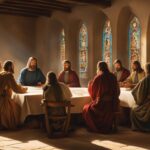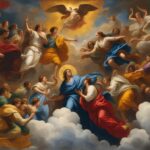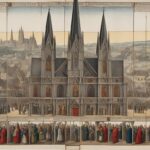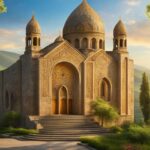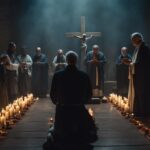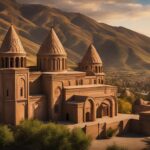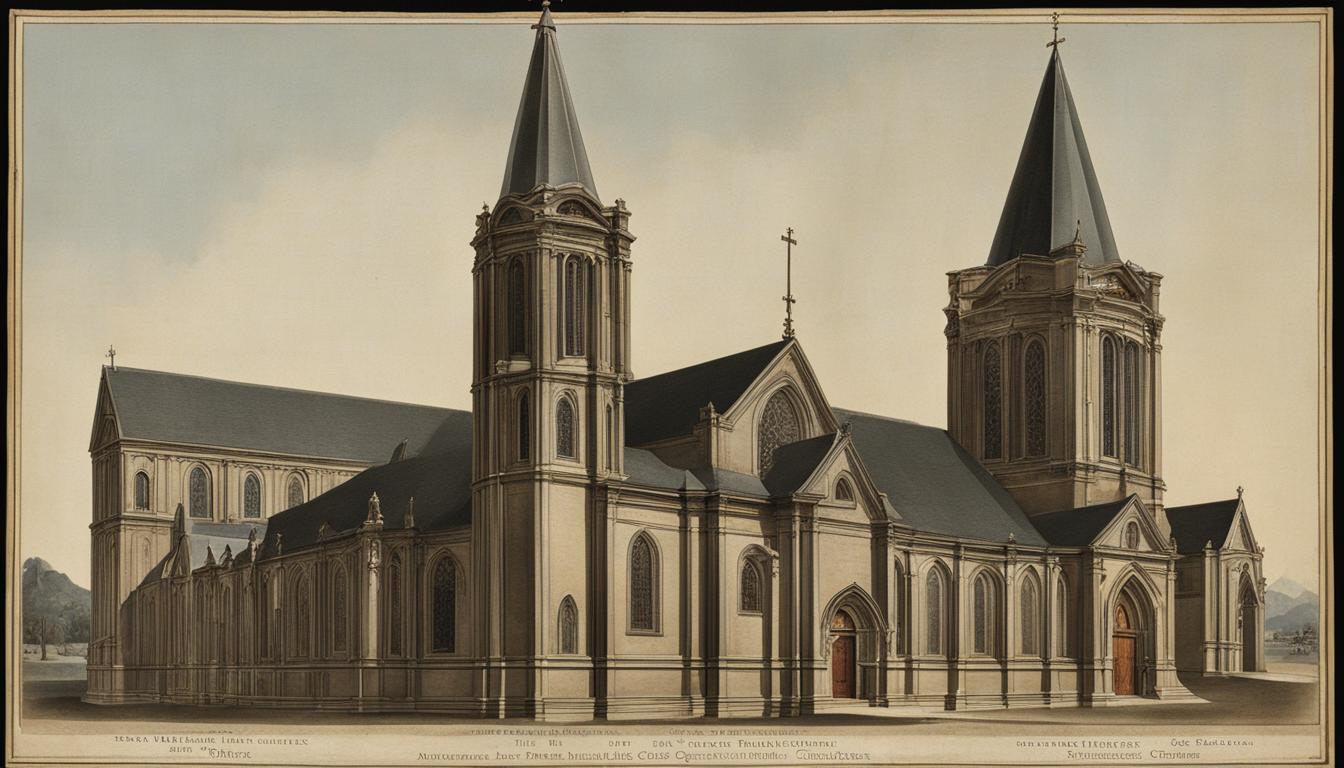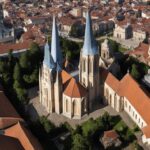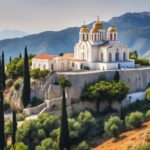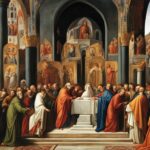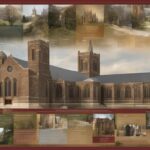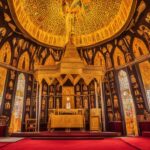The Orthodox Church has a rich and ancient history that dates back to the time of Jesus Christ and the Apostolic Community. It is one of the oldest Christian traditions, with a direct and unbroken continuity with the early Church.
Throughout its history, the Orthodox Church has faced numerous challenges and triumphs. For nearly 300 years, it endured persecution in the Roman Empire, but with the Edict of Milan in 313, Emperor Constantine granted Christians freedom of worship, leading to a period of growth and expansion.
The Orthodox Church has witnessed periods of growth, internal development, missionary activity, and schisms. One of the most significant events in its history was the Great Schism in 1054, which led to the separation of the Roman Catholic Church and the Eastern Orthodox Church.
The Eastern Orthodox Church, also known as the Orthodox Church, has since evolved into a distinct branch of Christianity, known for its deep reverence for tradition, rich liturgical practices, and timeless teachings.
Key Takeaways:
- The Orthodox Church traces its origins back to Jesus Christ and the Apostolic Community.
- The Church experienced periods of growth, development, and schisms throughout its history.
- The Great Schism in 1054 led to the separation of the Roman Catholic Church and the Eastern Orthodox Church.
- The Orthodox Church is known for its deep reverence for tradition and rich liturgical practices.
- It is one of the oldest Christian traditions and has a direct continuity with the early Church.
Beliefs and Doctrines
The Orthodox Church holds steadfast to a set of core beliefs and doctrines that form the foundation of its faith. These beliefs shape the Orthodox Christian worldview and guide the spiritual journey of its followers.
One of the fundamental beliefs of the Orthodox Church is in the Holy Trinity, the belief that God exists in three distinct persons: the Father, the Son (Jesus Christ), and the Holy Spirit. This concept highlights the divine nature and unity within the Godhead.
The Orthodox Church also affirms the divinity and humanity of Jesus Christ. It teaches that Jesus, the second person of the Trinity, took on human flesh through the Incarnation, becoming fully God and fully human. This belief sets Orthodox Christianity apart from other Christian denominations.
Central to Orthodox belief is the conviction in the Resurrection of Jesus Christ. Orthodox Christians commemorate and celebrate the resurrection of Christ as the ultimate triumph over sin and death, which provides salvation and the hope of eternal life.
The Last Judgment is another important doctrinal belief for the Orthodox Church. It teaches that at the end of time, God will judge the living and the dead, rewarding the righteous with eternal joy and punishing the unrepentant sinners.
The Orthodox Church upholds the teachings of the Seven Ecumenical Councils, which were convened between the 4th and 8th centuries. These councils addressed various theological controversies and established important doctrines such as the divine nature of Jesus, the veneration of icons, and the nature of the Holy Spirit.
Tradition holds a significant place in Orthodox Christian belief. The Orthodox Church regards Tradition as the transmission of divine revelation and authority from the early Christian Church to the present day. Tradition encompasses teachings, practices, liturgical worship, and the decisions of the ecumenical councils, ensuring the continuity of Orthodox faith through the ages.
The Orthodox Church holds a unique perspective on the concept of original sin, viewing it as ancestral sin. While inherited from Adam and Eve, ancestral sin does not carry the same guilt as original sin. Instead, it represents the inherent fallen human nature and the propensity for sin.
One of the notable features of Orthodox Christianity is the veneration of icons, which are sacred images of Christ, the Virgin Mary, and the saints. Icons are considered windows to the divine and serve as aids in prayer and meditation. Their use is deeply rooted in the spiritual life and worship of Orthodox believers.
“The Orthodox Church stands firm in its belief in the Holy Trinity, the divinity and humanity of Jesus Christ, the Resurrection, and the Last Judgment. It values Tradition, venerates icons, and upholds the decisions of the Seven Ecumenical Councils.”
These core beliefs and doctrines shape the Orthodox Christian faith, providing spiritual guidance and fostering a strong sense of identity and unity within the Orthodox Church.
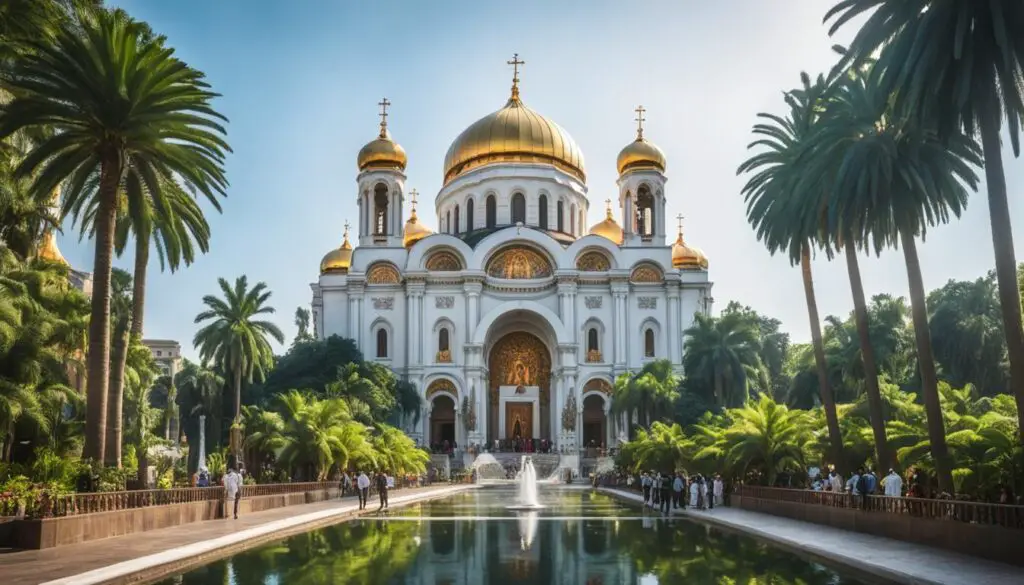
Sacraments and Rituals
In the Orthodox Church, sacraments play a central role in the spiritual life of believers. These sacred rituals not only serve as a means of grace but also symbolize the profound relationship between God and His people.
Baptism
Baptism is the sacrament of initiation into the Orthodox Church, marking the entrance of an individual into the life of faith. Through the triple immersion in water, believers are united with Christ and receive the forgiveness of sins.
Chrismation
Chrismation, also known as confirmation, is the sacrament through which believers receive the gift of the Holy Spirit. It follows immediately after baptism, sealing the newly baptized with the “seal of the gift of the Holy Spirit.”
Eucharist
The Eucharist, or Holy Communion, is the central act of worship in the Orthodox Church. It is the sacrament of the Body and Blood of Christ, offered to believers as a means of spiritual nourishment and union with God.
Confession
Confession, or the sacrament of Penance, is the opportunity for believers to confess their sins to a priest and receive absolution. It is seen as a means of healing and renewal, restoring the soul to a state of spiritual well-being.
Ordination
Ordination is the sacrament through which men are set apart and consecrated for the holy priesthood. It involves the laying on of hands by a bishop, conferring upon the ordained the authority to perform Holy Mysteries and shepherd the faithful.
Marriage
Marriage in the Orthodox Church is considered a sacrament, a mystical union between a man and a woman. It is celebrated with profound reverence and is seen as an image of the union between Christ and His Church.
Anointing of the Sick
The sacrament of the Anointing of the Sick is administered to those who are ill or facing a physical or spiritual challenge. Through the anointing with holy oil and prayers, believers are given strength, comfort, and healing.
Rituals and Celebrations
The Divine Liturgy stands as the pinnacle of Orthodox worship, a solemn and reverent liturgical service that encompasses the sacrament of the Eucharist. Other important rituals and celebrations include the Blessing of Water, which takes place on the feast of Epiphany, and the observances of Great Lent, Holy Week, and the Paschal Vigil.

Seven Sacraments of the Orthodox Church
| Sacrament | Description |
|---|---|
| Baptism | The sacrament of initiation into the Orthodox Church, uniting believers with Christ through water immersion. |
| Chrismation | The sacrament following baptism, through which believers receive the gift of the Holy Spirit. |
| Eucharist | The central sacrament of the Orthodox Church, the receiving of the Body and Blood of Christ in Holy Communion. |
| Confession | The sacrament of Penance, providing believers the opportunity to confess their sins and receive absolution. |
| Ordination | The sacrament through which men are consecrated for the holy priesthood. |
| Marriage | The sacrament of the union between a man and a woman, celebrated as a reflection of the union between Christ and His Church. |
| Anointing of the Sick | The sacrament administered to those who are ill or facing physical or spiritual challenges, providing strength and healing. |
Leadership and Clergy
The Orthodox Church is renowned for its strong and well-defined leadership structure, which plays a vital role in maintaining the integrity and spiritual guidance of the church. At the helm of each autocephalous church is a patriarch or a high-ranking bishop, responsible for overseeing the affairs of the church within their respective jurisdictions.
The Ecumenical Patriarchate of Constantinople holds honorary primacy within the Orthodox Church, signifying its historical significance and influential position. The Ecumenical Patriarch is considered the “first among equals” among the patriarchs and plays a crucial role in promoting unity and cooperation among the various autocephalous churches.
The clergy of the Orthodox Church consists of bishops, priests, and deacons, all of whom have distinct roles and responsibilities within the church community. Bishops are appointed to oversee specific geographical regions called dioceses. They bear the significant responsibility of providing spiritual and administrative leadership to the faithful in their dioceses.
Priests, on the other hand, serve in local parishes and are responsible for the day-to-day spiritual care of the congregants. They perform various sacraments, lead worship services, and provide pastoral guidance and counseling to the members of their parish.
Deacons, the third rank of the clergy, assist in the liturgical services. They play a crucial role in the rituals and ceremonies of the church, supporting both the bishop and the priest in their respective roles and ensuring the smooth conduct of worship.
The orthodox clergy are regarded with deep respect and reverence by the faithful, as they are considered the spiritual shepherds of the church community. They are expected to lead by example, upholding the teachings and traditions of the church while providing guidance and support to the members of the Orthodox Church.
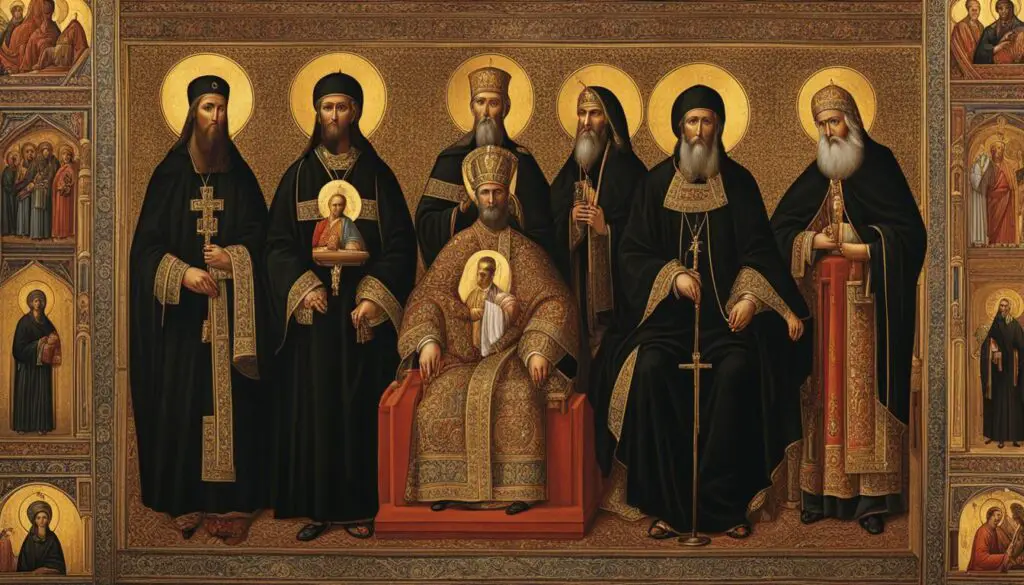
- The Orthodox Church is led by patriarchs or high-ranking bishops.
- The Ecumenical Patriarchate of Constantinople holds honorary primacy.
- The clergy consist of bishops, priests, and deacons;
- Bishops provide spiritual and administrative leadership in their dioceses.
- Priests serve in local parishes and offer pastoral care.
- Deacons assist in liturgical services and support the clergy.
Worship Practices
The Orthodox Church embraces a deeply reverent and symbolic approach to worship. Its liturgical services are characterized by intricate chants and hymns, incense, processions, and the veneration of icons. Orthodox worshipers actively participate in the service, making the sign of the cross, bowing, and responsively singing prayers and hymns.
The liturgical year is marked by a calendar of feasts and fasts, with Easter standing as the most significant celebration. These rituals and traditions define the spiritual journey of Orthodox believers, guiding them through the cyclical rhythm of faith.
Whether gathering in majestic cathedrals or humble parish churches, Orthodox worship unites the faithful in a profound experience of divine communion and reflection.
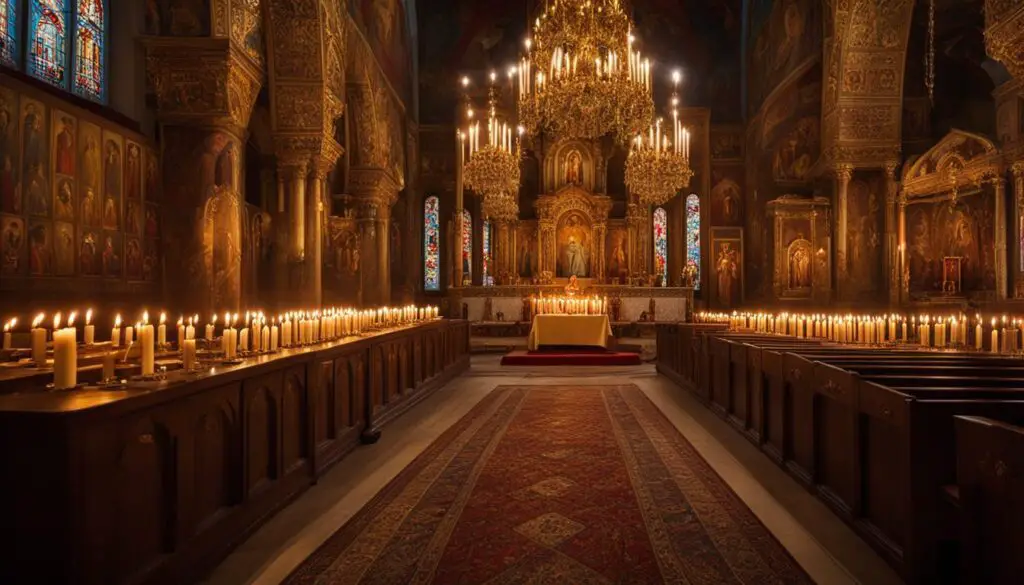
Sacred Texts
The Orthodox Church holds sacred texts in high regard, recognizing the Bible as the inspired Word of God. It encompasses both the Old Testament, which predates the birth of Jesus Christ, and the New Testament, which contains the teachings of Jesus and the early Christian community.
One significant text within the Orthodox tradition is the Septuagint, a Greek translation of the Hebrew Bible. The Septuagint plays a vital role in Orthodox theology and worship, as many of the passages read during liturgical services are based on this translation. It is considered a valuable resource for understanding the religious and historical context in which the Orthodox Church emerged.
In addition to the Bible, the Orthodox Church also regards certain liturgical texts as sacred. The Divine Liturgy, which is the central act of worship in Orthodoxy, is accompanied by specific prayers and liturgical hymns. These texts guide the faithful in their worship and provide a profound connection to the historical liturgical practices of the early Church.
Denominations and Sects
The Orthodox Church is comprised of various autocephalous churches, each with its own unique customs, traditions, and liturgical styles. These denominations and sects contribute to the diverse tapestry of Orthodox Christianity, while still maintaining the fundamental beliefs and practices of the Orthodox faith.
Some of the major autocephalous churches within the Orthodox Church are:
- Church of Constantinople
- Church of Alexandria
- Church of Antioch
- Church of Jerusalem
- Russian Orthodox Church
These Churches serve as spiritual centers and have their own hierarchies and structures. They play an essential role in preserving and propagating the Orthodox faith.
In addition to these major autocephalous churches, there are also numerous Eastern Orthodox churches in other countries, including Serbia, Romania, Bulgaria, Greece, and Ukraine. These churches have their own distinct characteristics, traditions, and cultural influences, reflecting the unique histories and identities of their respective regions.
Though these various denominations and sects may have some differences in liturgical practices, traditions, and administrative structures, they are all united by their adherence to the Orthodox faith and shared commitment to the teachings and doctrines of the early Church.
Significant Autocephalous Churches and Jurisdictions:
| Denomination or Jurisdiction | Headquarters |
|---|---|
| Church of Constantinople | Istanbul, Turkey |
| Church of Alexandria | Alexandria, Egypt |
| Church of Antioch | Antioch, Syria |
| Church of Jerusalem | Jerusalem, Israel |
| Russian Orthodox Church | Moscow, Russia |

Community and Outreach
The Orthodox Church deeply values the sense of community and the importance of outreach. Church members actively engage in charitable works, extending a helping hand to those in need. They provide food, shelter, and healthcare to individuals and families facing difficult circumstances. The Orthodox Church recognizes the significance of compassion and service as essential expressions of their faith.
Additionally, the Orthodox Church actively participates in ecumenical dialogues, forging relationships with other Christian denominations and religions. This commitment to interfaith dialogue fosters understanding, promotes peace, and encourages cooperation among different faith communities. By seeking common ground and shared values, the Orthodox Church contributes to the broader unity of the global Christian family.
Furthermore, the Orthodox Church emphasizes the importance of community for the spiritual growth and support of its members. Through regular gatherings, events, and fellowship activities, believers come together to nurture their faith, build relationships, and find solace in shared experiences. This sense of community creates a supportive environment where individuals can deepen their spirituality and find strength in their Orthodox identity.
Architectural and Artistic Features
The architectural style of Orthodox churches is renowned for its distinctiveness and grandeur. These magnificent structures are characterized by large domes that rise proudly above the landscape, serving as beacons of spiritual awe and devotion.
One of the prominent features of Orthodox church architecture is the iconostasis, a beautifully adorned screen that separates the sanctuary, where the altar is located, from the nave, where the congregation gathers. The iconostasis holds immense religious significance and is intricately decorated with icons, portraying saints, biblical scenes, and theological symbolism.
“The iconostasis stands as a visual representation of the divine realm, connecting the earthly worship space with the heavenly realm,” explains renowned architect Sophia Makrakis.
Orthodox church art, specifically iconography, plays a vital role in the worship and spiritual life of Orthodox Christians. Icons are sacred images carefully painted on wood panels, capturing the divine presence of Christ, the Virgin Mary, and the saints. They serve as sacred windows, inviting worshippers into a mystical encounter with the heavenly realm.
“Icons are not merely decorative artworks; they are windows to the sacred, guiding us towards a deeper connection with God,” says renowned iconographer Andrei Vasilevsky.
Byzantine art and mosaics also adorn many Orthodox churches, offering a visual feast of vibrant colors, intricate designs, and religious narratives. These artistic expressions not only enhance the aesthetic beauty of the sacred spaces but also convey profound theological messages, immersing worshippers in the richness of their faith.
| Architectural and Artistic Features | Description |
|---|---|
| Large Domes | Distinctive structures that symbolize the heavenly connection |
| Iconostasis | An adorned screen separating the sanctuary from the nave, adorned with icons |
| Iconography | Sacred images capturing the divine presence and serving as windows to the sacred |
| Byzantine Art and Mosaics | Vibrant artworks conveying theological narratives |
Contemporary Issues and Challenges
The Orthodox Church, like many religious institutions, grapples with contemporary issues and challenges that arise in the modern world. These challenges encompass both internal debates and external pressures, necessitating a delicate balance between tradition and adaptation.
One prominent issue facing the Orthodox Church is the secularization of society. As traditional religious beliefs and practices become less prevalent in modern life, the Orthodox Church faces the challenge of engaging with a society that is increasingly disconnected from its spiritual and religious roots.
Another challenge is the declining church attendance, particularly among younger generations. The Orthodox Church must find new and innovative ways to connect with younger individuals and make its teachings and practices relevant to their lives.
The Orthodox Church also grapples with the need to adapt to cultural changes while maintaining its traditions. This includes discussions and debates regarding women’s roles in the clergy, the role of the laity, and social issues such as LGBTQ+ rights.
Internal discussions within the Orthodox Church about women’s roles in the clergy are ongoing. Some factions argue for a more inclusive approach, advocating for the ordination of women into priestly and even episcopal roles. Others argue for the preservation of tradition, which limits such roles to men.
Similarly, the role of the laity in the decision-making processes of the Orthodox Church is another area of debate. Some members believe that increased lay involvement would strengthen the Church’s connection to its communities, while others hold firm to the hierarchical structure of leadership.
Social issues, such as LGBTQ+ rights, also present challenges for the Orthodox Church. Balancing the teachings of the Church with the evolving societal understanding of gender and sexuality is a complex task that requires careful thought and consideration.
| Contemporary Issues and Challenges | Impact | Approaches |
|---|---|---|
| Secularization of society | Limited engagement with modern society, decreased relevance | Increasing efforts in outreach and community involvement |
| Declining church attendance | Loss of younger generations, reduced influence | Adopting new approaches to connect with younger individuals |
| Debates on women’s roles in the clergy | Internal divisions and questioning of traditional norms | Continued dialogue and potential reevaluation of practices |
| Role of the laity | Desire for increased involvement and decision-making | Exploring ways to enhance lay participation and leadership |
| Social issues (e.g., LGBTQ+ rights) | Conflicting interpretations of teachings and societal changes | Seeking a compassionate and inclusive approach while maintaining core beliefs |
Addressing these contemporary issues and challenges requires careful consideration and thoughtful dialogue within the Orthodox Church. The ability to adapt while staying true to its core beliefs and traditions will be crucial in ensuring the continued relevance and impact of the Orthodox Church in the modern world.
Orthodoxy in the United States
The Orthodox Church has established a strong presence in the United States, with numerous parishes and communities across the country. The Orthodox faithful in America actively engage in worship, community activities, and outreach, fostering a vibrant and flourishing spiritual community.
One of the largest jurisdictions within the Orthodox Church in the United States is the Greek Orthodox Archdiocese. With its rich cultural heritage and deep-rooted traditions, the Greek Orthodox Archdiocese encompasses a significant portion of the Orthodox Christian population in the country.
However, it is important to note that the Orthodox Church in the United States is not limited to a single jurisdiction. Other Orthodox jurisdictions also contribute to the ecclesiastical landscape, representing the diverse heritage and traditions of Orthodox Christianity.
The Orthodox Church in America (OCA), an autocephalous church, plays a significant role in uniting Orthodox Christians across different ethnic backgrounds. It offers a home for believers seeking a diverse and inclusive spiritual community.
The Antiochian Orthodox Church, rooted in the ancient Patriarchate of Antioch, has established a vibrant presence in the United States. Its rich liturgical traditions and commitment to community outreach make it a key player in American Orthodoxy.
The Russian Orthodox Church Outside of Russia (ROCOR) also has a notable presence in the United States, offering spiritual guidance and support to Orthodox Christians of Russian heritage.
Collectively, these jurisdictions, and others not mentioned, contribute to the growth and vitality of the Orthodox Church in the United States.
The presence of the Orthodox Church in the United States reflects the diversity and religious freedom that the country embodies. Orthodox Christians in the United States actively seek out opportunities for worship, spiritual growth, and involvement in their local communities.
Whether it is participating in liturgical services, engaging in educational programs, or joining in charitable works, Orthodox Christians in the United States demonstrate a strong commitment to their faith and a desire to live out the teachings of the Orthodox Church.
The Orthodox Church in the United States serves as not only a place of worship but also as a source of guidance and support for individuals and families navigating the challenges of modern life. It provides a sense of community and belonging, where individuals can find solace, moral compass, and spiritual nourishment.
To locate an Orthodox Church near you, simply use the search function or visit the official websites of the respective jurisdictions – Greek Orthodox Archdiocese, Orthodox Church in America, Antiochian Orthodox Church, or Russian Orthodox Church Outside of Russia. Additionally, you can consult local directories or seek recommendations from fellow Orthodox Christians to find a parish that suits your spiritual needs.
Conclusion
The Orthodox Church has a rich and enduring history that spans over two millennia. Rooted in the teachings of Jesus Christ and the Apostolic Community, the Orthodox Church has preserved its ancient traditions, beliefs, and doctrines, providing a spiritual haven for millions of believers worldwide.
The Orthodox Church’s sacraments, rituals, and worship practices are imbued with deep reverence and symbolism, creating a profound spiritual experience for its members. The veneration of icons, the Divine Liturgy, and the annual cycle of feasts and fasts contribute to the richness of Orthodox worship.
Despite facing challenges in the modern world, such as secularization and cultural changes, the Orthodox Church remains steadfast in its commitment to preserving its traditions and reaching out to the community. With a strong sense of community and a dedication to charitable works, the Orthodox Church actively promotes unity, compassion, and social justice.
In the tapestry of Christianity, the Orthodox Church stands as a vibrant and influential strand. Its contributions to sacred texts, architectural and artistic features, and the ongoing dialogue within its various denominations and sects have shaped the broader landscape of religious practice.
FAQ
What is the history of the Orthodox Church?
The Orthodox Church traces its origins back to Jesus Christ and the Apostolic Community. It believes in a direct and unbroken continuity with the early Church.
What are the beliefs and doctrines of the Orthodox Church?
The Orthodox Church believes in the Holy Trinity, the divinity and humanity of Jesus Christ, the Incarnation, the Resurrection, and the Last Judgment. It upholds the Seven Ecumenical Councils that proclaimed and defended fundamental doctrines.
What are the sacraments and rituals of the Orthodox Church?
The Orthodox Church recognizes seven sacraments: baptism, chrismation (confirmation), Eucharist, confession, ordination, marriage, and anointing of the sick. The Divine Liturgy is the central act of worship in the Orthodox Church and is conducted with great reverence and ritual.
How is the Orthodox Church led?
The Orthodox Church is organized into autocephalous churches, each led by a patriarch or other high-ranking bishop. The Ecumenical Patriarchate of Constantinople holds honorary primacy. The clergy consist of bishops, priests, and deacons.
What are the worship practices of the Orthodox Church?
Orthodox worship is characterized by its rich symbolism and reverence. The liturgical services are conducted with intricate chants and hymns, incense, processions, and the use of icons. Worshipers participate actively by making the sign of the cross, bowing, and singing responses.
Which texts are considered sacred in the Orthodox Church?
The Orthodox Church recognizes the Bible as the inspired Word of God. It includes the Old Testament, as well as the New Testament. The Septuagint, a Greek translation of the Hebrew Bible, holds particular importance in the Orthodox Church.
Are there different denominations within the Orthodox Church?
The Orthodox Church is comprised of various autocephalous churches, each with its own unique customs, traditions, and liturgical styles. The major autocephalous churches are the Church of Constantinople, the Church of Alexandria, the Church of Antioch, the Church of Jerusalem, and the Russian Orthodox Church.
How does the Orthodox Church engage in community and outreach?
The Orthodox Church places great importance on community and outreach. Church members participate in charitable works, including providing food, shelter, and healthcare to those in need. The Church also engages in ecumenical dialogue and fosters relationships with other Christian denominations and religions.
What are the architectural and artistic features of Orthodox churches?
Orthodox churches are known for their distinctive architectural style, characterized by large domes, iconostasis (a screen adorned with icons separating the sanctuary from the nave), and beautiful interior artwork. Iconography plays a significant role in Orthodox worship, with icons depicting Christ, the Virgin Mary, and saints.
What are some contemporary issues and challenges facing the Orthodox Church?
The Orthodox Church faces various challenges in the modern world, including the secularization of society, declining church attendance, and the need to adapt to cultural changes while maintaining its traditions. There are also ongoing debates and discussions within the Orthodox Church regarding women’s roles in the clergy, the role of the laity, and social issues such as LGBTQ+ rights.
What is the presence of the Orthodox Church in the United States?
The Orthodox Church has a presence in the United States, with numerous parishes and communities across the country. The Greek Orthodox Archdiocese is the largest jurisdiction, but there are also other Orthodox jurisdictions, such as the Orthodox Church in America, the Antiochian Orthodox Church, and the Russian Orthodox Church Outside of Russia.

